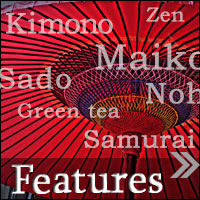Sake
Sake history
Famous Sake production place is “Fishimi”, Kyoto, Japan. Ancient Kyoto had a bigger lake than Lake Biwa (the largest lake in Japan, now).

Water pulls by upheaval of the ground and ancient people live in the marshy ground. Seems like when people learned cultivation, started Sake making at the same time.
Fushimi was a ground with high quality abundant subsoil water. The location name “Fushimi” is came from subsoil water in Japanese.near the foot of a mountain it became a spring, is clear and pure good water for brewing Sake.
Basically, Sake process is the first polish the material (rise), and the next saccharificate the starch using yeast of malted rice, then the fermentation.
The tribe of rice “Iwai” is especially for Sake, is ease to polish and low protein contains and it is ideal material for Ginjo type (Gijo type is natural fermentated rice wine).
Characteristic of Sake of Kyoto
There are many famous, traditional even international Sake companies in Kyoto. For example, Gekkeikan if you look for Sake in a restaurant (even not in Japan), you ‘ll find easily, Gekkeikan Sake.
The fact to make the taste of Sake is amount (%) of minerals contained in the water. The water of Fushimi contains minerals properly and it makes comfortable touch, mild taste Sake.
The “Goko-no-miya” shrine has indispensable spring water for Sake of Fushimi. Originally the shrine had another name but in 862 gushed springs out and its water has a noble aroma. The water is soft water and it is one of the seven major spring water, it says without this water is not possible to make Fuishimi Sake.

Kyoto and Sake’s relation
Kyoto has many festivals from the long time ago. One of them there is a festival of Sake brewery. In Heian-jingu of Okazaki area, all parties of brewery industry present and prey for the year production and their safety. The brewery is affected by lot of nature so since the ancient time the festivals are continued every year.

- Kyoto Cuisine
- Kyoto Cuisine
- Shojin Cuisine
- Tofu
- Umaki
- Atsuage
- Saikyo Yaki
- Kyoto Sweets
- Kyoto Sweets
- Kuzukiri
- Yatsuhashi
- Tsukemono (Picles)
- Tsukemono (Picles)
- Green Tea
- Green Tea




